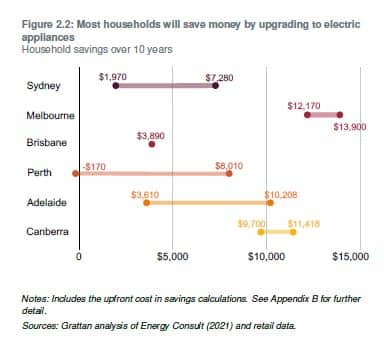ALP governments are continuing a push to electrify households as part of the shift to a zero-carbon energy society. The ACT is one of the most advanced jurisdictions in that respect, and as of last month has made adjustments to its own household electrification scheme.
The premise of the ACT initiative, the Sustainable Household Scheme, is that it is cheaper to run households on renewable electricity than gas. However, the cost of switching to electric appliances can be prohibitive for many people.
For instance, an electric induction cook-top costs on average $400 more than a gas stove. Heat-pump hot water systems cost an extra $1,500 than gas.
Larger households may need to update circuitry to switch over heating, hot-water and kitchens to electricity, particularly in the cooler states. This can cost $4,500-$6,000 in a one-off upgrade.

The ACT is leading the way with subsidies for lower asset value homes. As of last month, interest-free loans with repayments over 10 years are available for purchasing electric appliances where the home is worth less than $750,000. Energy efficiency improvements such as insulation and household batteries can also be included. Solar can be installed for homes worth below $450,000.
For units, the cut-off value is $300,000 or less. The same subsidies are also available to pensioners, veterans and Health Care Card holders.
Victoria runs a similar but less generous program. It subsidises electric hot-water systems and reverse-cycle air conditioning to the tune of $1,000.
As these programs are designed to electrify households, there is little on offer for tenants. A major exception, however, is electric vehicles, which some studies and policies frame as part of household electrification.
In the ACT, renters can access the same, 10-year interest-free loan, but rather than upgrading their home the money can be put toward the cost of buying an electric car. The only apparent limitation in the scheme guidelines is that the car cost less than the luxury car tax threshold, currently $89,000.
Given the asset-value test, the ACT initiative is obviously somewhat limited. But according to the Grattan Institute, implementing such an initiative nation-wide is possible, with a $5,000 electrification subsidy costing $25 billion.
Such policies are key because carbon emissions from gas make up 22% of Australia’s emissions. In Victoria, NSW and the ACT, much of this usage comes from households, and is therefore easily replaceable with electricity. Yet the number of residential gas customers in these states has grown substantially since 2010, by 37% for NSW and 22% for Victoria.
Such policies have achieved their goals elsewhere. Japan subsidised installation of electric heating and hot-water systems from 2001 to 2010. Around 90% of homes there now have these electric appliances. Electric appliances are now widely subsidised in EU countries.
Sign Up To Our Free Newsletter